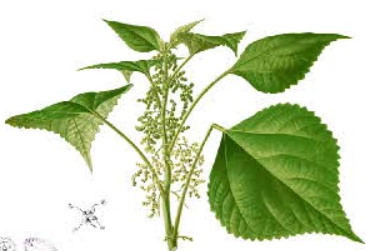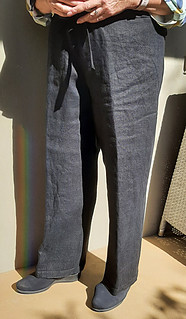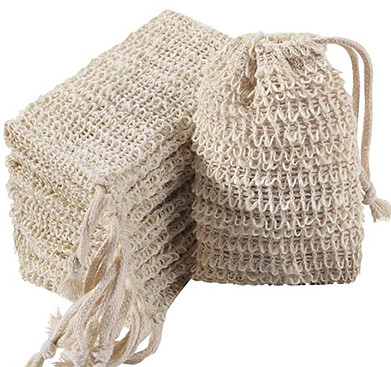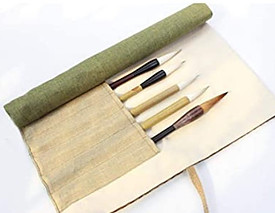Have you ever wondered what material is ramie? Or what is ramie made of? Ramie is a linen-like fiber which is classified as a cellulose fiber and is made from the stalks of the Chinese nettle plant.
What is Ramie Fabric?
Ramie is an eco friendly fabric and the highly sustainable fiber is an alternative to synthetic fabrics. It is naturally resistant to mold, mildew and bacteria, as well as light damage and rot and insect attacks. It can be healthily grown without any pesticides, herbicides and chemicals.
Ramie is made from the stalks of flowers and plants and is a chic vegan silk alternative and is lighter and airier. It is able to maintain shapes well. .
Ramie fabric is gaining popularity in the fashion industry as a sustainable eco fiber. Ramie is also known as China grass, grass linen, rhea and grass cloth. It can be grown without harmful chemicals as it can naturally resist various pests and diseases, making it a typical environmentally green crop. 
Ramie is a flowering plant and in the nettle family, Urticaceae. The scientific name is Boehmeria Nivea. Stinging nettle is also called European nettle and you can read more about the production of nettle fabric in this post on Innovative Textile Solutions.
What material is ramie? It is a vegetable fiber that is noted for its length and toughness. The word ramie comes from the Malay word rami. Ramie is classified as a cellulose fiber, and although Ramie is not a very common fabric, it is considered sustainable.
Ramie Cultivation
Ramie is best grown in loamy and sandy loam soil with a Ph of between 5.5 and 7.0. A warm humid climate is essential for cultivating ramie. The annual rainfall needs to be between 1,500mm and 3,000mm and well distributed throughout the year. Optimum temperature for growing ramie is 25 degrees Celsius and 35 degrees Celsius.
The herbaceous perennial grows 1 to 2.5 meters tall and is native to eastern Asia. The perennial plant grows like a shrub and is also called Chinese nettle. It produces numerous unbranched stems from underground rhizones and has a crop life of 6 to 20 years. 
There are two types of ramie:
- True ramie or China grass, is also called white ramie or Chinese plant. The leaves are heart shaped and the underside is white, with dense, small hairs that give it a silvery appearance. The difference to stinging nettles is that the hairs do not sting.
- A second type of ramie is known as green ramie or rhea and is generally believed to have originated in the Malay Peninsula. The leaves are smaller and green on the underside and seems to be better suited for tropical conditions.
Ramie is one of the oldest fiber crops and have been used for fabric production for more than 6,000 years. It is a bast fiber and for textile production, the fiber from the inner bark, or phloem, of the vegetative stalks, are used, rather than the woody stem or bark.
Harvesting Ramie
Ramie is normally harvested 2 to 3 times per year, but it can be harvested up to 6 times per year if the growing conditions are good. Ramie is different to other bast crops in that it requires chemical processing to degum the fiber.
Harvesting of ramie takes place when the plant starts flowering, or just before that. Flowering is a signal that the plant is at both the maximum fiber content and also at a decline in growth.
- Stems are harvested by bending the stem or cutting just above the lateral roots. This enables the core to be broken and the cortex can be stripped from the plant in situ.
- The stems are decorticated while the plants are still fresh. Plants will dry out and the bark will be difficult to remove if decortication is not done while the plants are fresh.
- The bark ribbon is then dried as quickly as possible to prevent attacks from bacteria and fungi.
Extraction of Ramie Fiber
The process of transforming the ramie fiber into a textile, is similar to the process that is used to produce linen fabric from flax. You can discover more about the process in this post on linen production and flax cultivation.
flax. You can discover more about the process in this post on linen production and flax cultivation.
Ramie fiber is very fine, like silk, and naturally white in color. Fiber extraction takes place in three stages:
- The cortex or bark is mechanically removed or it is done by a machine. This process is called decortication.
- The cortex is scraped to remove most of the outer bark, the parenchyma, in the bast layer, as well as some of the pectins and gums.
- The residual cortex material is washed, dried and then degummed to extract the spinnable fiber.
Ramie is often blended with other natural fibers and the fabric will resemble anything from fine linen to coarse canvas.
Wet spinning produces a high luster, softer yarn. Dry spinning results in a hairier, harsher yarn.
The several steps that involve scraping, pounding, heating, washing or exposure to chemicals, makes the extraction and cleaning of the fiber, and what is ramie fabric, expensive. This has given what material is ramie, limited acceptance to be used in textiles. Most of these steps are all needed to separate the raw fiber from the adhesive resins and gums.
History of What Material is Ramie
For many centuries ramie has been grown in China, and it is known that farmers used the fiber to weave clothing in ancient China. It is possible that it was used in Egypt to wrap mummies. This would make sense as ramie has a resistance to mildew and bacteria, which is appropriate for mummy wrapping.
In the late 1930s Brazil started producing what is ramie fabric, and production peaked in 1971. Production since then has steadily declined, mainly because of competition from alternative crops like soybeans and also synthetic fibers.
Producers: China is the main producer of ramie and they mainly export to Japan and Europe. Taiwan, India, the Philippines, South Korea, Thailand and Brazil are the other producers. Very little ramie is available on the international market, as it is mainly used in the domestic markets of the countries that grow ramie.
Properties of Ramie
So what is ramie made of? Ramie is a cellulosic fiber and therefore has many of the properties of cellulose fabric. Cellulose fibers are discussed in this post on Viscose Fabric – the textile made from cellulose. 
- Ramie is one of the strongest natural fibers and is even stronger when it is wet and eight times stronger than cotton.
- It introduces a silky luster to the appearance of fabric.
- Fibers are uneven, which gives ramie fabric an appearance that is similar to linen.
- It is known for its ability to hold shape and reduce wrinkling.
- Ramie is not as durable as other fibers, so it is usually blended with other fibers, such as cotton, linen and wool.
- The microscopic appearance and absorbency and density are similar to linen.
- It does not dye as easily and well as cotton.
- Ramie lacks resiliency and is low in elasticity and elongation potential. It does mean that it does not easily shrink.
- Because it lacks elasticity and stretch, it is often blended with wool to make knitting yarns.
- The molecular crystallinity is high, making ramie stiff and brittle and the fiber will break if it is repeatedly folded in the same position.
- Because it is somewhat stiff and brittle, it is great for coarser products like twine, rope and nets.
Ramie is specially known for the ability to hold shape. The fabric appearance has a silky luster. It is perfect for beach wear as it is even stronger when wet. Fine gauge ramie is sheer and swimwear can be seen beneath the fabric, giving it a sexy, yet elegant effect. What is ramie fabric is perfect for pool, beach and around the resort.
Advantages of Ramie
The properties of ramie mean that there are several advantages to ramie fabric.
- Naturally resistant to bacteria, mildew, rotting, alkali, light and insect attacks.
- It is extremely absorbent, making it very comfortable to wear.
- Fairly easy to dye, although not as well as cotton.
- It has natural resistance to stains.
- The strength increases when it is wet.
- It can withstand high temperatures when it is washed.
- It has a smooth and lustrous appearance that improves with laundering.
- Ramie keeps it shapes well and does not shrink.
- It can be bleached.
- It is durable and strong, with a tensile strength that is eight times that of cotton and seven times more than silk.
Ramie linen is a crisp dressmaking fabric which has the same feel and look as linen, but it is better priced than 100% pure linen. It has the sort of texture that softens with washing and wearing. I recently used it to sew trousers and Japanese aprons.
Amazon has great deals on ramie fabric so explore your options here.
Disadvantages of Ramie
In the same way that the properties of ramie means that what material is ramie has certain advantages, it also has certain disadvantages when it comes to what is ramie fabric.
- Low in elasticity.
- It has low abrasion resistance.
- It lacks resiliency and is stiff and brittle.
- The de-gumming process is essential.
- It wrinkles easily.
- Ramie is expensive to produce due to the labour-intensive processes during harvesting, decortication and production.
Uses of Ramie
Spinning the ramie fiber is difficult because of the low elasticity and brittleness. Lack of cohesion between the fibers results in a hairy surface of the yarn, and this makes it difficult to weave. 
- Ramie is used to make products such as pouches and brush holders, packing materials, soap wash bags, industrial sewing thread, filter cloths and fishing nets.
- It is also made into fabrics for clothing and household furnishings, like canvas and upholstery. It is often blended with other textile fibers.
- Shorter fibers and waste are used to manufacture paper.
- Industrial uses of ramie include parachute fabrics, fire hoses and canvas.
- The short fibers are used to produce high quality paper goods like bank notes and cigarette papers.
- Ramie ribbon is used as a substitute for traditional linen tape in fine bookbinding.
- The leaves are occasionally used in Chinese and Vietnamese cooking.
- Ramie is also used as an ornamental plant in eastern Asia.
The versatility of ramie fiber allows it to be made into fine yarns. It can be used in garments ranging from dresses and suits, to jeans and sports wear. By blending ramie with wool, the fabric is lighter and shrinkage is minimized.
Caring for Ramie Fabric
When it comes to ramie fabric care, always look at the fabric care labels in your garments, as these vary according to fiber blends and manufacturing processes.
Garments made from 100% ramie should not require any special care. Washing and ironing at high settings should not harm fiber.
When it is blended with other fibers, color retention and shrinkage might be affected. If it is blended, then machine wash in cold water on a gentle cycle, or hand washing, will give best results.
Avoid ironing sharp creases in the fabric as constant creasing can cause the fiber to break.
Common Questions about What Material is Ramie
What is the difference between ramie and linen? Ramie is made from the stalk of the Chinese nettle plant, whereas linen is made from the stalks of the flax plant.
whereas linen is made from the stalks of the flax plant.
Is ramie sustainable? Ramie does not require any herbicides or pesticides to be grown. It is a highly sustainable fiber which is an eco friendly alternative to synthetic fibers.
What is ramie made of? Ramie, with the botanical name of Boehmeria Niveau, is part of the nettle family and is made of natural fibers. It is also called Chinese grass, Chinese linen, grass linen or grass cloth.
Is ramie fabric natural or synthetic? ramie is a natural cellulose fiber, so no, it is not synthetic.
Final Thoughts on Ramie
Improved processing methods and the need to find alternatives to plastic, may lead to greater utilization of ramie. The popularity of ramie will continue to rise as the fashion industry becomes more and more eco conscious.
If you have any experience about what material is ramie, or have any questions or suggestion about what is ramie fabric, then please leave your comments below and I will get back to you.

What is the best material to use as a lining for a garment made from ramie linen please ? I will be making a jumpsuit from ivory ramie linen & would like to complete with the most suitable material ( hanging, movement etc taken into account )
Marge
Hi Marge, I would use a natural fabric, like organic cotton or silk, that is breathable and lightweight. I hope it helps.
Very interesting! I was looking for info on linen-rami blend and came across article. Good to know it is a natural fabric. Will it be suitable for kids clothing?
Hi there, yes, ramie linen is perfect for kids clothing. I have used it for trousers, skirts and even Japanese chef aprons. It is a lovely fabric to work with and I found it better priced than pure linen. I hope it helps. All the best, Liné
Hi Line Cowley
Thanks for sharing the complete information on Ramie. Oh my goodness! You explain everything – the advantages, disadvantages, its history in the past, how to care for it, its main uses. I was glad to see everything in detail including its cultivation, harvesting and extraction. I was helping my son to prepare a project on ramie and I got everything at a single place .thanks for saving a lot of my time providing information brisk and clear.
Thanks and regards,
Gaurav Gaur
I am pleased to hear that you found the post helpful. All the best, Liné
Hi,thank you for sharing this .I have seen pants and shirts before who look like they are made from Ramie .They really look very nice .How can I differentiate it from linen when I see one ?I really like the look of the pants ,especially the one on the photo from the post .Is it possible to have an elastic around the waste for the pants ?This could make it a little bit flexible .Other than that ,I like this material and thank you very much for sharing
Ramie looks very much like linen and is often blended with lined as well. Labels in clothes and on fabric should tell you the fiber content, so look out for that. Different patterns can be used for garments that are comfortable and flexible.
Hi there and what an educational article! I have never heard of Ramie fabric and I am conscious of eco-friendly clothing so looking for sources of them. I enjoyed the history of this fiber and that its quite natural and made from plants. Great explanations of the advantages and disadvantages of this and it truly is strong and long lasting! Many thanks for the great tips throughout:)
Thank you for your kind comments and ramie indeed has some great benefits as a fabric.
An informative article. I grew up in an area where stinging nettle plants were common. I think there was some research on the stinging nettle plant with the possibility that it has some medicinal properties.
I have heard Ramie is also a good fire retardant material when combined with poly lactic acid based biocomposites.
The uses for this plant ( like many others), seem to be endless. It is also blended with other fibers for use in concrete (fibre reinforced concrete). Research into the uses for these vegetable fabrics is an ongoing process, who knew that bamboo clothing would become as popular as it has,
I have no problem buying clothing made from these plants, They tend to durable, hold there color and always feel comfortable to wear.
Thank you for the informative post.
I have not heard about ramie being used with polylactic acid based biocomposites, so I will have a look at that.
I’ve never heard of ramie but it sounds like a great material. The fact that it is so tough and resistant to things like stains, bacteria, etc. makes it sound like a great option for clothing. As I live in the US, it is not as easy to come across as cotton clothing. It’s cool that you can iron it without having to worry too much about damaging it. Thanks for the article!
Ramie is a great material and looks and feels very much like linen and you should be able to find it in the USA. I hope this helps.
Thanks so much for sharing a great article to learn more about what material is ramie, as I’m a sewer I love to learn about any new textile fiber that is being used, I think I’ve heard about ramie before but I didn’t pay much attention to it, so reading your article was a full learning to me. As I live in Canada I’ve seen this plant in our backyard and the more I learn about it make it a very interesting plant, I know it’s better not to touch to avoid any skin problems, but I’ve been learning it can be boilded and it’s good, but today when I was reading your article I got to know it makes a good textile fiber, I love all natural fibers for clothing and I love the natural wrinkles, and I loved to know that it will help to keep some insects away!
Next visit to the fabric store, I will pay attention to any ramie fabric, I would love to make something with this fabric.
Ramie can be touched without causing itchiness, it is the stinging nettle that has hairs on the underside of the leaves that will sting you. I have just made some trousers with ramie linen and it is a lovely fabric to work with and also feels good on the skin when I’m wearing it.
I would like to share a few interesting additional facts concerning Ramie. This fabric is easy-care, increases in strength when wet, and does not shrink or lose its shape. Another benefit is that it dries quickly and like linen becomes smoother and more lustrous with repeated washing.
For those that are interested in history, it can be mentioned that Ramie has been grown in China for many centuries and it may have been used in cloth for wrapping mummies in Egypt.
Ramie has several benefits and is a great natural fiber to wear.
I have found this extremely interesting as I have never heard of Ramie before.
I can’t believe how quickly it grows and that it can be harvested up to 6 times a year. That’s incredible.
It is just unfortunate that it is expensive to process when it can be so easily produced.
Thank you for sharing this information.
Ramie looks very much like linen and can easily be blended with other natural fibers like cotton and linen to produce fabric.
I love that more manufacturers are seeking to use sustainable materials and this looks like another good one! Being to harvest this a number of times a year makes it readily available and it would seem that this is durable and would last a long time. I do have concerns about the need to use chemicals to degum it, though. How do these chemicals affect the environment?
It is indeed great that more manufacturers are looking for and using sustainable materials. Chemicals need to be disposed of in an eco friendly way in order not to be harmful to the environment.
Great article you have here and thank you for sharing such an informative article. I literally had no idea of what ramie was. And after reading your article, am pretty sure ramie is a great useful material for fabrics considering it is one of the strongest fiber, despite not being durable as compared to other fibers.
Ramie is one of the oldest fibers that have been used for many years for making anything from fabric to rope and string. It is even stronger when it is wet.